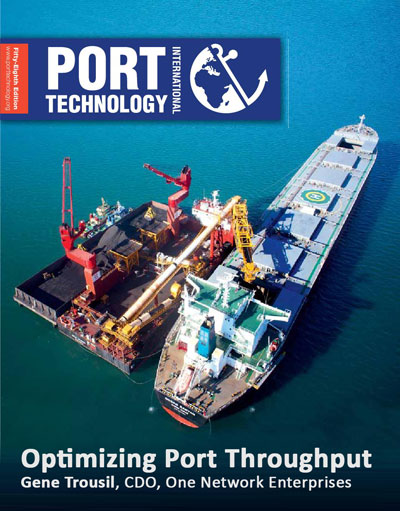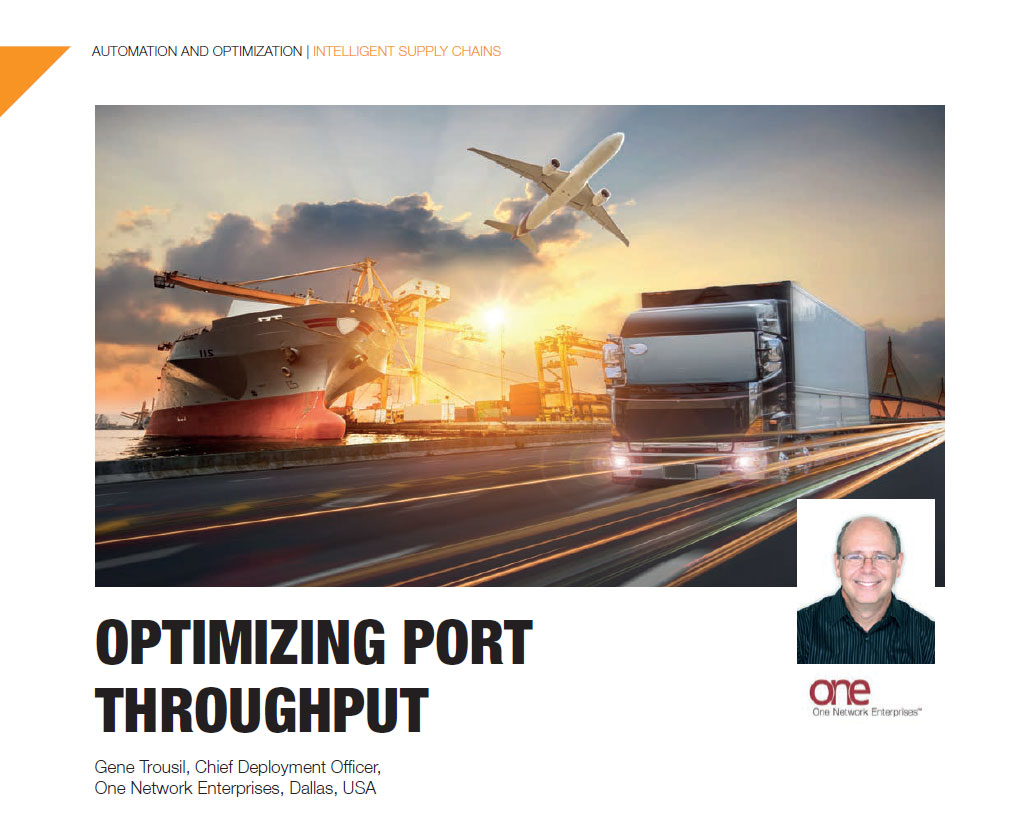This post has already been read 6734 times!
Ports play a critical role in international trade, yet they remain major sources of friction in global supply chains. It’s time to change that. Here’s how…

If we had to choose one word to describe the state of the world today, “hyper-connected” would be a good choice. It has fueled the growth of commerce around the world. Our ports serve as gateways for those goods, speeding or impeding their passage from source to customer.
With this rapid expansion of global business in the last few decades, port operations have become more critical than ever for global companies and their customers.
Shipping volumes have slowly inched up, with the top 15 ports in Europe experiencing 14 percent growth in the last 10 years, according to PortEconomics.eu.
Also, ships have steadily grown larger, putting more strain on terminals and port operators, while ever-changing regulations and growing security concerns have further complicated matters.
Let’s look at the problems and see how we can solve them and deliver better service to the customer at lower cost.
As global trade has accelerated, ports remain sticking points in our global supply chains that slow the flow of goods, raise costs and undermine customer service. It's time to change that... Share on XHow Ports Operate Today
While the world has grown more connected and interdependent, our ports often operate as isolated islands, with little connection to what’s happening upstream and downstream in the supply chain. This causes a host of problems, including a lack of visibility, and poor communication and coordination among ports, terminals, and ocean and landside carriers.
This is a major concern for ocean shippers. In Ports and Shipping: The Need for Solutions that Cross Lines, McKinsey notes that shippers are very dissatisfied with service. Their top complaints are:
- Poor availability of equipment, and poor reliability (exacerbated by poor communication when things go wrong).
- Frequent disruptions at ports often attributed to labor strikes and driver shortages, but many shippers suspect they are due to bad decisions on the part of ocean freight providers and port operators.
McKinsey notes that the most urgent need is for improved transparency and communication. Shippers want more reliable delivery dates and better communication when things go wrong. But, why is visibility and coordination so difficult to achieve?
Dated and entrenched enterprise technology is hurting supply chains. This can be seen in ports where inefficiencies are rife due to lack of visibility, proper planning and optimization. Share on XThe chief reason for this is that most ports, terminals, and carriers operate with decades old technology, many with their own messaging systems, and few, if any, common standards. This is true across the supply chain. The systems evolved and became entrenched in an era before globalization, and before the rise of the internet and the cloud.
So, the problem remains. Our ports, though global gateways, are a bit like the tower of Babel, with minimal communication and visibility beyond the terminal. This makes it difficult to anticipate, prepare, and to smooth the flow of goods from the terminal through to transportation. While this is understandable, it’s not easy to connect the myriad of systems each company and organization uses to share information and gain better visibility to the supply chain. However, it does cause a host of problems that ripple up and down the supply chain.

Problems from Upstream and Downstream Blindness
Too often, ports are ill-prepared for the arrival of ships. Typically, they ask carriers when their ships will arrive. The carriers check with the captains, and then relay the information back to the ports. This manual and roundabout method introduces major errors. According to McKinsey, these estimates are off by an average of 13 hours.
This lack of predictability and reliability means ports and terminals cannot plan effectively, and are often ill-prepared for cargo arrivals, and may not have the resources needed to offload and handle it in a timely and efficient manner. On the other hand, when an expected ship fails to show on time, resources are tied up unnecessarily in idle anticipation.
This lack of visibility manifests on the landside too. With no visibility to container contents, nor to the urgency of demand, containers are usually unloaded ad hoc, and fed into transportation modes without regard for the actual demand for that cargo. Commodity items with no urgency could easily take precedence over critical shipments that are holding up a production line.
Without this information, cargo unloading cannot be prioritized and appropriate and cost-effective transportation cannot be selected and prepared. Parts needed to keep a factory in production may be delayed while other non-urgent commodities are off-loaded, simply because no one knows what’s in the containers, who needs it, and how badly.
Depending on the cargo and the urgency, this can have a serious impact downstream. Critical cargo may be delayed, forcing a factory shutdown, or inventory for an expensive promotion could dry up. Thus, these problems spill beyond the port and ripple through the supply chain, delaying ships unnecessarily, causing stock outs, and lost sales at stores. They can make or break a promotion or a product launch and, ultimately, they can affect a manufacturer or retailers’ reputation and customer loyalty.
The good news is that with recent developments in technology, particularly in innovations in cloud technology such as multi-party digital business networks, companies can side-step the problem of untangling and integrating disparate technologies and messaging systems. They can connect to a digital network, and let the network do the translation for them.

From Isolated Islands to Digital Networks
Imagine if ports, terminals, and landside carriers, had visibility into incoming cargo well in advance. And not only how many containers, but also the container contents and the urgency of the shipment. Ports could prepare for the workload and ready any required equipment. Cargo could be unloaded in order of priority to speed up the flow of critical goods. The appropriate transportation mode could be selected, based on costs and the urgency of demand.
Real time multi-party network inform all relevant parties of supply and demand statuses, so they can plan for upstream arrivals and plan accordingly to optimize downstream transportation. Share on XPerhaps a retailer has an expensive nationwide promotion running and is almost out of stock. Shouldn’t those containers jump to the head of the queue? The success of a promotion, or of quarterly results, could depend on it.
Digital networks with real-time data that flows across all supply chain nodes make this a reality. With better data comes better planning, and more efficient and reliable operations. In addition, real-time data carries a profound, yet often ignored, benefit; it inspires confidence. When average vessel arrival times are off by 13 hours, it diminishes confidence in the data and trust in the carriers. However, this data is critical to driving derivative decisions at the terminal and down the line, such as allocating equipment and drivers.
With today’s technology, there is no reason for critical information not to be shared. Multi-party networks can connect all parties in real time, providing a single version of the truth. Strong, permissibility frameworks ensure that each party has access to only the information it needs.
– Gene Trousil, One Network Enterprises
This real-time data is critical to keeping ports, terminals, and carriers in sync. As conditions change, for example a ship is delayed, all relevant parties are alerted immediately and can plan accordingly to minimize disruptions downstream.
These networks provide the much-needed visibility and transparency, but also provide backbone for communication and collaboration in resolving issues. Social applications like live chat and Twitter-like micro-blogging apps make real-time communication quick and easy, while capturing and logging the communications and tying them to the relevant transactions and workflows.
Advanced digital networks are technology agnostic. They embrace a diversity of legacy systems and have adapters that integrate with ERP systems and a multitude of messaging formats. They also facilitate the adoption of new technologies, and can incorporate live streaming data from third parties and devices, such as IoT (Internet of Things) services.
Advanced multi-party networks use artificial intelligence to support better decision-making and optimize all aspects of the supply chain, from container prioritization to inventory levels and transportation mode and route selection. For such networks, GPS tracking of ships, trucks and even temperature conditions within a container, is not unusual. This data forms a rich backdrop that can be served up to dashboards to alert operators and supply chain managers to changing conditions and issues, so they can be proactive in resolving issues.
In short, by unifying all parties and data on a single network, multi-party networks allow ocean carriers, port operators and landside carriers to see opportunities for improvement that were previously invisible. Optimizing one node in the supply chain is good, but it has little effect if other nodes are subject to delays and constraints which impede the flow of goods further. Dramatic improvements come from coordinating all parties across the ecosystem more intelligently and efficiently.
Digital Business Networks Keep Pace with Progress
Successful companies today all excel at uniting the supply chain around satisfying the consumer quickly and efficiently. Ports and terminals operators and carriers play a vital role in this ecosystem, provided they can overcome the technological challenges. With multi-party digital networks, the technological hurdle is rapidly diminishing. Organizations can connect to the network once, and still use their existing legacy systems while enjoying increased visibility up and downstream and transacting with other organizations in real time.
With multi-party business networks, not only can organizations catch up to new technologies quickly, they can also keep abreast of market and technology trends. A major advantage of these business networks is that they often include Software Development Kits (SDKs) for rapidly adapting applications or building new ones. These applications can be made available to the entire ecosystem. This means that the portfolio of network apps is continually growing and adapting to new challenges and leveraging new technologies as they emerge, helping companies stay agile and on the forefront of technological developments.
Download this article as a PDF
Download this article as a PDF
Recommended Reading on Global Trade and Logistics
[contentblock id=7 img=gcb.png]
- How to Optimize Port Throughput in Global Supply Chains - March 22, 2018
- Big Opportunity for Logistics Providers?Supply planning and inbound services…. - October 26, 2015
- How logistics providers can offer order promising and delivery services - August 7, 2015

